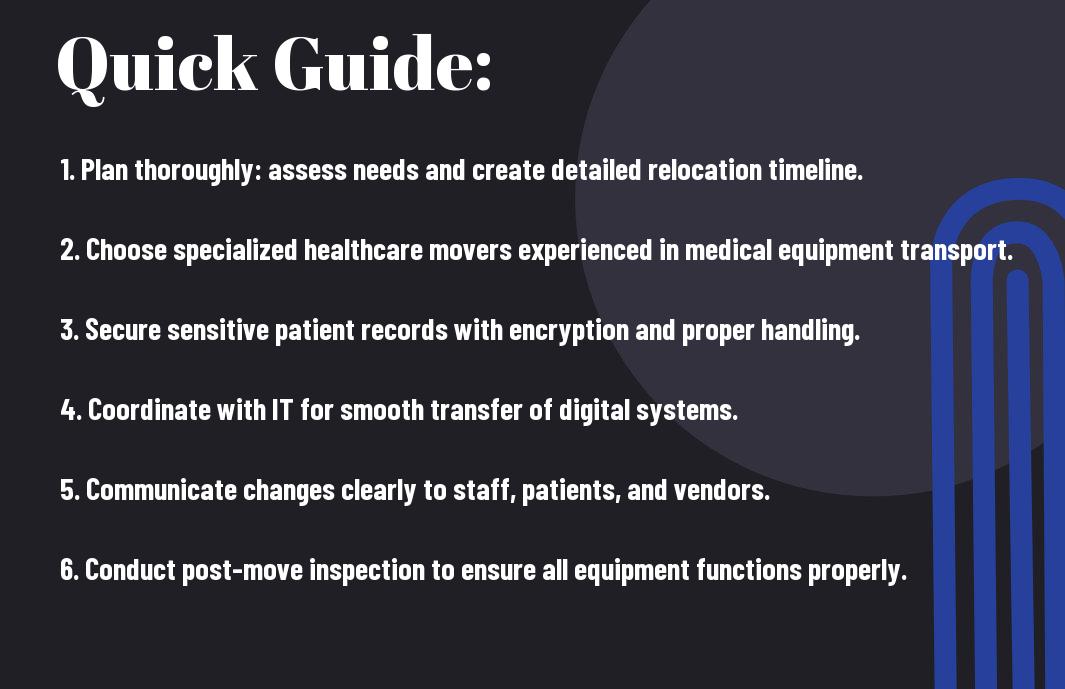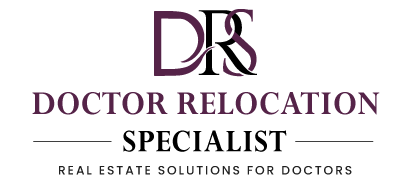Healthcare providers like you face unique challenges when relocating a medical practice. Whether you’re moving to a larger space or simply seeking a better location, efficient planning is imperative to ensure minimal disruption to your services. This ultimate guide will provide you with expert insights and practical solutions to streamline your relocation process, helping you transition smoothly while maintaining quality care for your patients. Get ready to discover the best strategies for a successful move that benefits both you and your practice.

The Logistics Labyrinth: Navigating Relocation Planning
Relocating your medical practice involves navigating a complex web of logistics. From understanding zoning laws to coordinating IT infrastructure, meticulous planning mitigates unexpected hurdles. Assessing your current space versus future requirements and establishing a detailed timeline ensures a smooth transition, minimizing disruptions to patient care and daily operations.
Assessing Your Current Space Needs
Evaluating your present facility is crucial in determining what you truly need for your new practice location. Consider factors like patient volume, equipment storage, and staff requirements. Analyzing these parameters allows you to make informed decisions about space utilization, ensuring your new environment supports your practice’s growth and operational efficiency.
Critical Timeline Development and Milestones
Creating a timeline with specific milestones provides structure to your relocation process. Start by outlining significant tasks, such as securing a new lease, scheduling buildouts, and planning the move itself. By assigning deadlines to each task, you can track progress effectively and allocate resources more efficiently, reducing the risk of overwhelm.
A well-defined timeline should begin several months before the move, incorporating milestones like finalizing contracts, starting renovations, and alerting vendors about your relocation. For instance, securing your new space ideally occurs at least six months prior to the move date. This foresight enables you to address unforeseen challenges, such as construction delays or compliance issues, ultimately streamlining the entire relocation process for a successful transition.

Beyond Boxes: Tailoring Moving Solutions for Medical Practices
Relocating a medical practice involves more than just packing boxes and transporting items. Successful moves require customized solutions designed to meet the unique needs of healthcare providers. Each medical facility has specific requirements, from handling sensitive patient records to managing specialized equipment and ensuring minimal disruption to patient care. By understanding these nuances, moving companies can create tailored plans that ensure a seamless transition and maintain the integrity of your practice during the relocation process.
Specialized Equipment Handling and Transport
Your medical practice likely includes sensitive and costly equipment that demands careful handling. From imaging machines to surgical instruments, specialized equipment often requires professional moving teams trained in proper packing techniques and secure transport. Each item should be disassembled, wrapped, and transported with specific guidelines to prevent damage. By employing experts versed in healthcare logistics, you can ensure that your crucial tools arrive safely and ready for immediate use in your new location.
The Role of Technology in Streamlining Your Move
Integrating technology into your moving strategy can significantly enhance the efficiency of your relocation. Innovative software solutions enable real-time inventory tracking, scheduling, and communication between you and the moving company. Digital checklists can assist in managing the many components of your move, while virtual consultations can help plan layouts and space utilization in advance, minimizing downtime during the transition.
Utilizing technology not only streamlines logistics but also creates a more organized moving experience. For instance, cloud-based platforms allow for easy sharing of important documents, like insurance forms or equipment manuals, ensuring all team members have access to imperative information. Collaborating with a moving service that employs technology can lead to personalized dashboards for monitoring progress and prompt communication about any issues that arise. This proactive approach alleviates stress and empowers you to focus on providing care to your patients instead of the intricacies of your move.
Communicating Change: Keeping Patients and Staff Informed
Transitioning to a new practice location requires clear communication with both staff and patients to minimize disruptions. Establish regular updates through multiple channels such as newsletters, social media, and in-office posters to keep everyone informed about the move. By providing a timeline and sharing important details about the new location, you can foster a sense of security and confidence among your patients and staff. Transparency about changes helps minimize anxiety and ensures a smoother transition.
Effective Communication Strategies for Smooth Transitions
Utilizing a mix of communication methods is key to ensuring that your team and patients stay informed during the relocation process. Consider hosting informational meetings where staff can ask questions and express concerns, complement these with email updates detailing progress, and leverage social media to reach patients directly. This multi-faceted approach enhances clarity and demonstrates your commitment to keeping all stakeholders engaged and organized throughout the transition.
Managing Patient Expectations and Enhancing Satisfaction
Addressing patient expectations during your move directly impacts their overall satisfaction. Share insights about what your relocation means for them, such as improved facilities or extended hours, while also addressing any potential inconveniences they may face. Offering clear timelines helps patients understand when changes will occur and reassures them that their care will remain a priority during this transition phase.
In-depth communication regarding expected changes empowers patients to remain engaged rather than anxious. For instance, sending personalized messages detailing how the new location impacts their appointments and services builds trust. Incorporate feedback channels for patients to voice their concerns or ask questions. For optimal satisfaction, consider incentives such as promotional offers or special events at the new location. By actively involving your patients in the transition process, you foster loyalty and demonstrate an unwavering commitment to their well-being and care continuity.
Compliance and Regulations: Ensuring a Safe Move
Adhering to compliance and regulations is imperative when relocating your medical practice. This process not only safeguards your operational integrity but also protects patient safety and confidentiality. Understanding the specific requirements associated with your practice type—such as HIPAA regulations—ensures that sensitive information remains secure throughout the moving process. Additionally, collaborating with a moving company experienced in healthcare relocations can streamline compliance, minimizing the risk of costly penalties.
Navigating Legal Requirements and Healthcare Regulations
Understanding the legal landscape surrounding medical practice relocations involves more than just adhering to basic moving guidelines. You must familiarize yourself with local, state, and federal regulations relevant to healthcare facilities. This includes updating licensing information and notifying relevant authorities to maintain compliance throughout your transition. Employing an expert familiar with these legalities can safeguard your practice against potential pitfalls.
Implementing Risk Management Strategies
Risk management is vital during your relocation to help mitigate potential hazards and disruptions. Identifying risks ahead of time allows you to implement strategies to minimize downtime and protect your assets. This could involve thorough planning for equipment disassembly and transport or ensuring that the new location meets all safety standards before the move. Regular training for your staff and maintaining clear communication throughout the process can further solidify a smooth transition.
Effective risk management strategies begin with comprehensive risk assessment. Mapping out potential challenges allows your team to devise proactive solutions, such as utilizing specialized moving equipment for delicate medical devices or scheduling the move during non-peak hours to limit patient impact. Additionally, creating a detailed contingency plan ensures that you are prepared for unforeseen issues, ultimately safeguarding both your practice and your patients’ healthcare experience. Following these steps can greatly reduce the stress of relocation while ensuring a seamless transition into your new facility.
Setting Up Shop: Optimizing Your New Space for Efficiency
Once you’ve moved into your new medical practice, optimizing the space for efficiency maximizes both patient care and staff productivity. An effective layout can significantly reduce wait times, streamline processes, and create a comfortable environment conducive to health and wellness. Assess your needs, and make adjustments that improve workflow, such as strategically placing exam rooms and ensuring all medical equipment is user-friendly and easily accessible.
Smart Design Choices for Patient Flow and Engagement
Design decisions play a vital role in guiding patient flow and enhancing engagement in your practice. Open layouts minimize congestion, while clear signage helps direct patients seamlessly from one area to the next. Consider incorporating waiting areas with engaging visuals and comfortable seating, which can make the experience more pleasant for patients and reduce anxiety.
Leveraging Technology for Enhanced Operations
Integrating technology into your new space can vastly improve operational efficiency and patient experience. Electronic health record (EHR) systems streamline data access, while telemedicine options expand your care capabilities. Automated appointment reminders reduce no-show rates and improve patient communication, allowing you to focus more on delivering quality care rather than administrative tasks.
Embracing digital tools enhances your workflow and optimizes practice performance. Utilizing patient management systems can save time in scheduling and billing processes, while mobile apps allow for real-time patient engagement. The adoption of telehealth platforms not only extends your reach but also enables better monitoring of patient progress across various platforms, reinforcing your commitment to patient-centered care. Ultimately, investing in technology pays off by enabling you to provide quality care efficiently, creating a positive impact on both patient satisfaction and clinical outcomes.
To wrap up
Drawing together the key elements of your medical practice relocation, this guide empowers you to streamline the process effectively. By understanding logistics, engaging with specialized movers, and planning meticulously, you can minimize disruptions to your practice and enhance patient care. Your successful relocation hinges on well-informed decisions and preparation, enabling you to focus on what matters most—your patients and your practice’s future. Take action now to ensure a smooth transition and set the stage for continued success in your medical career.

